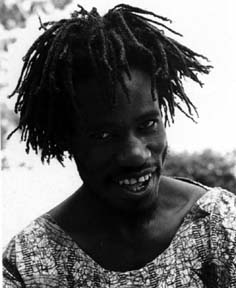Dominic Benhura
Joceline Mawdsley, Former Exhibitions Curator, Chapungu Sculpture Park, Harare
[ The following essay has been adapted with the kind permssion of the Director, Chapungu Sculpture Park, from Chapungu: The Stone Sculptures of Zimbabwe (1995). All images © Chapungu Sculpture Park, Harare.]
 Dominic Benhura was born in l968 in a small town of Murewa, some 100 kilometres north east of Zimbabwe's capital city, Harare. His father died before he was born, and he was raised by his mother. Benhura excelled at the local primary school and it was suggested that he attend school in Harare. His uncle Sekuru Gutsa had a family home in the high density suburb of Tafara, in Harare and it was here, at the age of ten, that Benhura went to live with his cousin Tapfuma Gutsa, an established sculptor in his own right, who introduced Benhura to art and sculpture.
Dominic Benhura was born in l968 in a small town of Murewa, some 100 kilometres north east of Zimbabwe's capital city, Harare. His father died before he was born, and he was raised by his mother. Benhura excelled at the local primary school and it was suggested that he attend school in Harare. His uncle Sekuru Gutsa had a family home in the high density suburb of Tafara, in Harare and it was here, at the age of ten, that Benhura went to live with his cousin Tapfuma Gutsa, an established sculptor in his own right, who introduced Benhura to art and sculpture.
Gutsa had gained art and wood carving experience at Serima Mission, and quickly became Benhura's friend and mentor. Benhura began to help Gutsa polish his pieces, later trying his hand at chisel and hammer, eventually carving small offcuts before moving onto large stone. Gutsa continued to support, nature and encourage Benhura and was pleased to see the young man develop his own individual style. Selling his first work to architects at the age of twelve, sculpting became a passion for
Benhura who would hurry home from school to work on hls pieces. After achieving excellent school results, he turned to sculpting full time and in 1987 he began to take his work to Chapungu Sculpture Park. In 1990, he joined the resident's programme and stayed there until 1995, when he acquired his new home in Athlone, Harare. At Chapungu he was encouraged to work on larger and more demanding stone and this period saw the introduction of his plant forms, including the "PawPaw Tree", "Euphorbia", and"Calabashes".
Benhura worked tirelessly for long hours at Chapungu, extending himself mentally, physically and creatively. By 1995 he was regarded as being amongst the most important second generation artists, his work sought after by both local and overseas collectors. These years also marked the beginning of overseas travel and he attended workshops in Botswana, United States, Belgium, Holland, Denmark and Germany. These travels broadened his outlook and brought much acclaim. Through the years, his willingness to innovate and experiment has led to many new techniques being included in his sculpture; threading cored stone onto metal rods, using nails bound together and then glued into stone to depict thorns.
Benhura however, refuses to limit himself to stone and freely uses any materials and techniques available. He is a young Eimbabwean who has chosen art as his career and believes that the only truth is within himself and his own experiences. He shuns books on art and says of his lack of formal art training: "I don't miss that. It is better my work is my own." Unlike
many of his contemporaries, he sketches profusely l and keeps a sketch book close at hand in order to record ideas as they come to him. Once he has selected the rock he needs for a certain sketch he abandons the sketch so that it does not dictate to him, letting his moods and feelings together with the intrinsic characteristics of the stone, control the final outcome. Acknowledged as a reader his recent massive work "Our HIV Friend" is an epic and further consolidates his position. Carved from a single 3-metre block of Spring Stone it talks openly of the terrible scourge of the Aids epidemic and the need for support from family and friends.
References
Mawdsley, Joceline. Chapungu: The Stone Sculptures of Zimbabwe. Harare: Chapungu, 1997.





 Dominic Benhura was born in l968 in a small town of Murewa, some 100 kilometres north east of Zimbabwe's capital city, Harare. His father died before he was born, and he was raised by his mother. Benhura excelled at the local primary school and it was suggested that he attend school in Harare. His uncle Sekuru Gutsa had a family home in the high density suburb of Tafara, in Harare and it was here, at the age of ten, that Benhura went to live with his cousin Tapfuma Gutsa, an established sculptor in his own right, who introduced Benhura to art and sculpture.
Dominic Benhura was born in l968 in a small town of Murewa, some 100 kilometres north east of Zimbabwe's capital city, Harare. His father died before he was born, and he was raised by his mother. Benhura excelled at the local primary school and it was suggested that he attend school in Harare. His uncle Sekuru Gutsa had a family home in the high density suburb of Tafara, in Harare and it was here, at the age of ten, that Benhura went to live with his cousin Tapfuma Gutsa, an established sculptor in his own right, who introduced Benhura to art and sculpture.